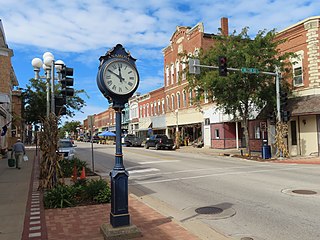
Anamosa is a city in Jones County, Iowa, United States. The population was 5,450 at the 2020 census. It is the county seat of Jones County.

Johann Carl Bodmer was a Swiss-French printmaker, etcher, lithographer, zinc engraver, draughtsman, painter, illustrator, and hunter. Known as Karl Bodmer in literature and paintings, his name was recorded as Johann Karl Bodmer and Jean-Charles Bodmer, respectively. After 1843, likely as a result of the birth of his son Charles-Henry Barbizon, he began to sign his works K Bodmer.

Visual art of the United States or American art is visual art made in the United States or by U.S. artists. Before colonization, there were many flourishing traditions of Native American art, and where the Spanish colonized Spanish Colonial architecture and the accompanying styles in other media were quickly in place. Early colonial art on the East Coast initially relied on artists from Europe, with John White the earliest example. In the late 18th and early 19th centuries, artists primarily painted portraits, and some landscapes in a style based mainly on English painting. Furniture-makers imitating English styles and similar craftsmen were also established in the major cities, but in the English colonies, locally made pottery remained resolutely utilitarian until the 19th century, with fancy products imported.

Grant DeVolson Wood was an American artist and representative of Regionalism, best known for his paintings depicting the rural American Midwest. He is particularly well known for American Gothic (1930), which has become an iconic example of early 20th-century American art.

Thomas Moran was an American painter and printmaker of the Hudson River School in New York whose work often featured the Rocky Mountains. Moran and his family, wife Mary Nimmo Moran and daughter Ruth, took residence in New York where he obtained work as an artist. He was a younger brother of the noted marine artist Edward Moran, with whom he shared a studio. A talented illustrator and exquisite colorist, Thomas Moran was hired as an illustrator at Scribner's Monthly. During the late 1860s, he was appointed the chief illustrator for the magazine, a position that helped him launch his career as one of the premier painters of the American landscape, in particular, the American West.

The Joslyn Art Museum, commonly referred to as the Joslyn, is a fine arts museum in Omaha, Nebraska, the largest in the state. It opened in 1931 at the initiative of Sarah H. Joslyn, in memory of her husband, businessman George A. Joslyn. Since its opening, the museum has gone through several expansions, the last of which was completed in 2024. It is the only museum in Nebraska with a comprehensive permanent collection, comprising over 12,000 objects, including nineteenth and twentieth-century collections of American and European art, Western American Art, Chinese and Japanese art, as well as contemporary art. The Joslyn is home to the Margre H. Durham Center for Western Studies, established in 1980, which stewards two of the most important collections of works by Western artists Karl Bodmer and Alfred Jacob Miller in the country.
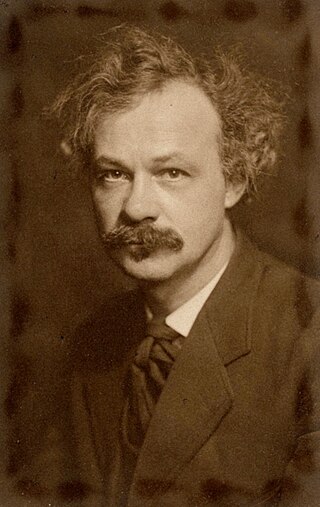
Jerome Myers was an American artist and writer associated with the Ashcan School, particularly known for his sympathetic depictions of the urban landscape and its people. He was one of the main organizers of the 1913 Armory Show, which introduced European modernism to America.

American Gothic is a 1930 oil on beaverwood painting by the American Regionalist artist Grant Wood. Depicting a Midwestern farmer and his daughter standing in front of their Carpenter Gothic style home, American Gothic is one of the most famous American paintings of the 20th century and is frequently referenced in popular culture.

Landscape painting, also known as landscape art, is the depiction in painting of natural scenery such as mountains, valleys, rivers, trees, and forests, especially where the main subject is a wide view—with its elements arranged into a coherent composition. In other works, landscape backgrounds for figures can still form an important part of the work. Sky is almost always included in the view, and weather is often an element of the composition. Detailed landscapes as a distinct subject are not found in all artistic traditions, and develop when there is already a sophisticated tradition of representing other subjects.

American Regionalism is an American realist modern art movement that included paintings, murals, lithographs, and illustrations depicting realistic scenes of rural and small-town America primarily in the Midwest. It arose in the 1930s as a response to the Great Depression, and ended in the 1940s due to the end of World War II and a lack of development within the movement. It reached its height of popularity from 1930 to 1935, as it was widely appreciated for its reassuring images of the American heartland during the Great Depression. Despite major stylistic differences between specific artists, Regionalist art in general was in a relatively conservative and traditionalist style that appealed to popular American sensibilities, while strictly opposing the perceived domination of French art.

Marvin Dorwart Cone was an American painter in the regionalist style.

The American Gothic House, also known as the Dibble House, is a house in Eldon, Iowa, designed in the Carpenter Gothic style with a distinctive upper window. It was the backdrop of the 1930 painting American Gothic by Grant Wood, generally considered Wood's most famous work and among the most recognized paintings in twentieth century American art. Wood, who observed the house only twice in his lifetime, made only an initial sketch of the house—he completed American Gothic at his studio in Cedar Rapids.
Lee Allen, born Edwin Lee Allen, was an American Regionalist painter, a muralist, and a medical illustrator, and an acclaimed ophthalmic photographer and ocularist.

Stone City is an unincorporated community and census-designated place in Jones County, Iowa, United States. Stone City began as a company town for the workers of the local quarries. Stone City is known for its Anamosa Limestone quarries, historic limestone architecture, and 1930s art colony. Its population was 186 persons in the 2020 census.
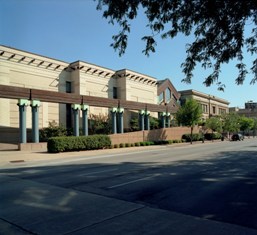
The Cedar Rapids Museum of Art is a museum in downtown Cedar Rapids, Iowa, United States. The museum is privately owned and was established in 1905. The museum acquired the old Cedar Rapids Public Library building after the library moved into a new location in 1985. The current home of the museum, designed by post-modern architect Charles Moore, was built adjoining the old library in 1989.
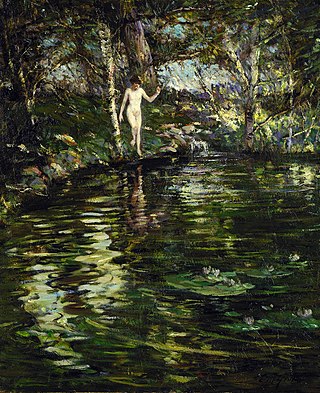
Lillian Mathilde Genth was an American impressionist artist. She is best known for her depiction of female nudes in landscape settings. However, in the middle of her career she swore off painting female nudes and began painting more conservative paintings inspired by her travels. In about 30 years Genth appeared in 233 exhibitions, and while well renowned for her paintings while alive, her story and artwork have been lost in the retelling of American art history.

Arnold Comes of Age is a 1930 oil painting by the American regionalist painter Grant Wood, created as a birthday gift for his studio assistant, Arnold Pyle. Wood took Pyle on as his protégé and was deeply affectionate towards him. The painting depicts a figure looking ahead in a rural landscape, as two nude men bathe in a river. It is reminiscent of Italian Renaissance artist Piero della Francesca's work, in particular The Resurrection, and it is interpreted as homoerotic from its detailing.
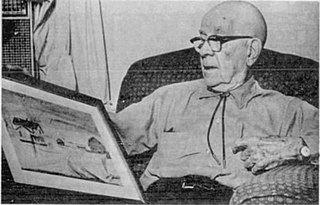
Robert Byron Tabor (1882–1972) was an American painter. He began his painting career when he was 51 years old. His artwork has been featured in the Museum of Modern Art, the Joslyn Art Museum, the White House, and other places. Tabor's first major artwork was Vendue in 1934 and his last major one was Discovery in 1962.
Robert Bauer is an American painter who creates pictures of people, landscapes, backyards, and gardens. Bauer's paintings of backyards and gardens gained him much recognition and his art has been shown in multiple exhibitions.
Aaron Gunn Pyle was an American painter known for his contributions to Regionalist painting. His work is closely tied to the Midwestern United States, the region where he was born and spent most of his life.

















